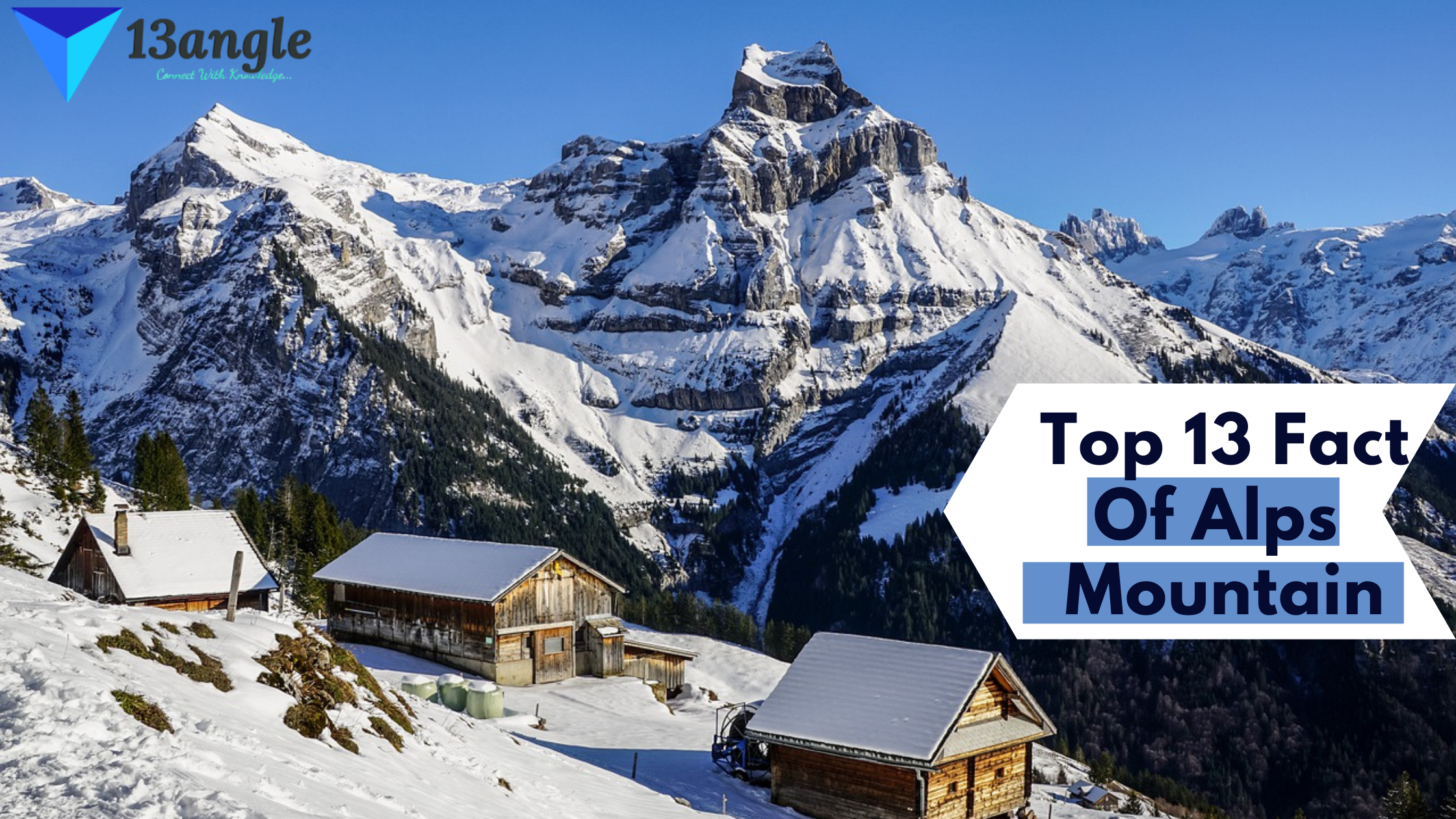Top 13 Fact Of Alps Mountain
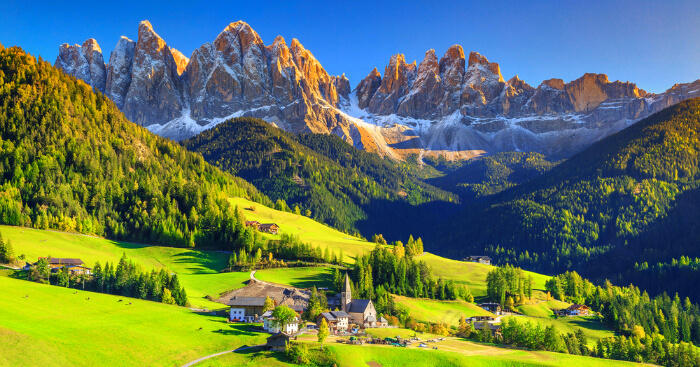
The Alps are the highest and the greatest mountain range of Europe. And it stretches approximately 1200 kilometres (around 750 miles) long and 125 miles wide at their broadest point between Garmisch-Partenkirchen, Germany and Verona, Italy. The alps covers more than 80000 square miles (207,000 square kilometres). The Alps stretches across eight Alpine countries namely France, Italy, Monaco, Switzerland, Austria, Slovenia, Germany and Liechtenstein. But Switzerland and Austria can be considered true Alpine countries.
- The Alpine arch extends from Nice on the Western Mediterranean to Trieste on the Adriatic and Vienna at Pannonian basin. The mountains were formed over ten millions of years as Eurasian and African plates are collided. Extreme shortening caused by the event resulted in marine sedimentary rocks rising by thrusting and folding into high mountain peaks like Mont Blanc and the Matterhorn.
- Mont Blanc is the highest mountain peak in the Alps. In the Alpine region area contains about hundred peaks higher than 4000 meters (around 13000 feet).
- The altitude and size of Alp mountain range also affects the climate in Europe.
- The Alpine region has a very strong cultural identity. Even today the traditional cultural such as Cheese Making, Wood Working and Farming still presents in the Alpine village. But after World War II, the tourism industry began to grow and expanded and become one of the most dormant industry by the end of the century.
- At present the Alpine region is the home of around 14 million people and has around 120 million visitors annually.
- The Winter Olympic Games have been hosted in Italian, German, French and Swiss Alps.
- The Alpine is also the source of some of the major rivers in Europe such as Rhone, Rhine, Po and numerous rivers tributaries of the Danube. And the waters of the Alps ultimately reaches the North, Mediterranean and Black Sea.
- And because of its arc like shape, the Alps separate the marine-coast climates of Europe from Mediterranean areas of France, Italy and Balkan region.
- Beside this, Alpine creates its own unique climate. Even most of the climates other than tropical climates are found on the Earth can be identified in the Alps and contrasts are also sharp.
- Long back in the year 1800, Nepoleon crossed one of the mountain passes with an army of 40,000 and one of the greatest motivational story is also associated with this.
- In the 18th and 19th century saw an influx of naturalists, writers and artists, in particular the Romantics followed by the golden age of alpinism as mountaineers began to ascend the peaks.
- In different European countries, Alps is known with different names such as: (1) In French= Alpes,
(2) In German= Alpen,
(3) In Italian= Alpi,
(4) In Slovene= Alpe
Geography And Passes
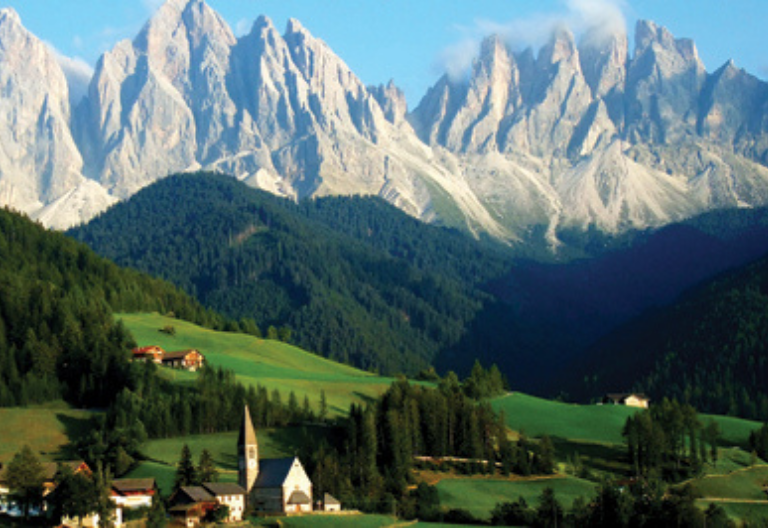
The Alps are a crescent shaped geographic feature of central Europe that ranges about 800 km (around 500 miles) arc (curved line) from east to west and is 200 km (around 120 miles) width. The mean height of the mountain peaks is 2.5 km (around 1.6 miles). The range of Alpine stretches from the Mediterranean Sea north above the Po basin which extends through France from Grenoble, and stretching eastward through mid and southern Switzerland.
The countries with the greatest Alpine territory are Austria (around 28.7% of the total area), Italy (around 27.2%), and Switzerland (around 13.2%) area.
The highest part of the range is separated by the glacial trough of the Rhone Valley from Mont Blanc to the Matterhorn and Monte Rosa on the Southern side, and the Bernese Alps on the north side.
The peaks are situated in the eastern part of the range in Austria and Slovenia are smaller than those in the central and western part.
According to the variance in nomenclature, Alps makes classification of the mountain and sub regions difficult, but the general classification of Eastern Alps and Western Alps divide between two occurring in eastern Switzerland near the Splugen Pass.
The highest peaks of Western Alps and Eastern Alps are as follows:-
Mont Blanc at 4810 meter (around 15780 feet)
Piz Bernina at 4049 meter (around 13284 feet)
The second highest major peaks are:-
Monte Rosa 4634 meter (around 15200 feet)
Ortler at 3905 meter (around 12810 feet)
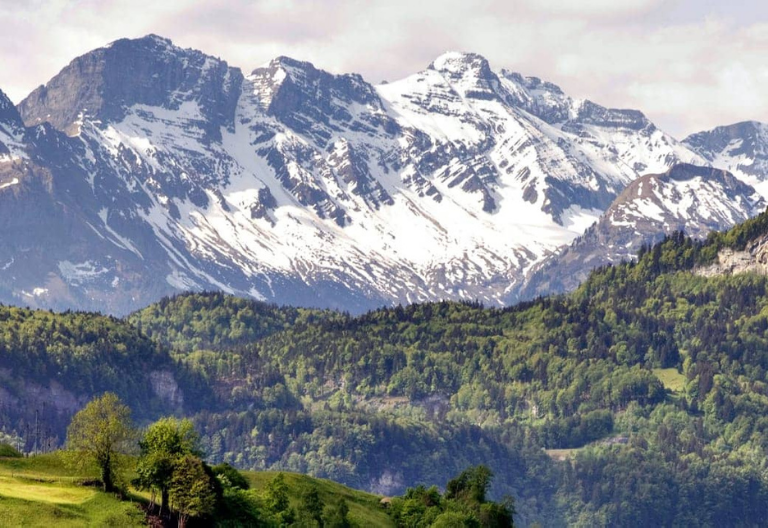

The Alps have been crossed for war and commerce, and by pilgrims, students and tourists. Crossing routes by road, train or foot are known as passes, and usually it consist of depressions in the mountains in which a valley leads from the plains and hilly pre-mountainous zones.
» The most important passes in the Alps are as follows:-
(1) Col de I’Iseran (highest pass)
(2) The Col Agnel
(3) The Mont Cenis
(4) The Brenner Pass
(5) The Great St. Bernard Pass
(6) The Col de Tende
(7) The Gotthard Pass
(8) The Sammering Pass
(9) The Simplon Pass and
(10) The Stelvio Pass
The Mont Cenis pass is the major commercial and military road built between Western Europe and Italy. And the pass was crossed by many troops on their way to the Italian peninsula.
The highest pass in the alps is the Col de I’Iseran (highest pass) in Savoy (France) at 2,770 m (9,088 ft), followed by the Stelvio Pass in northern Italy at 2,756 m (9,042 ft); the road was built in the 1820s.
Evolution Of Alps
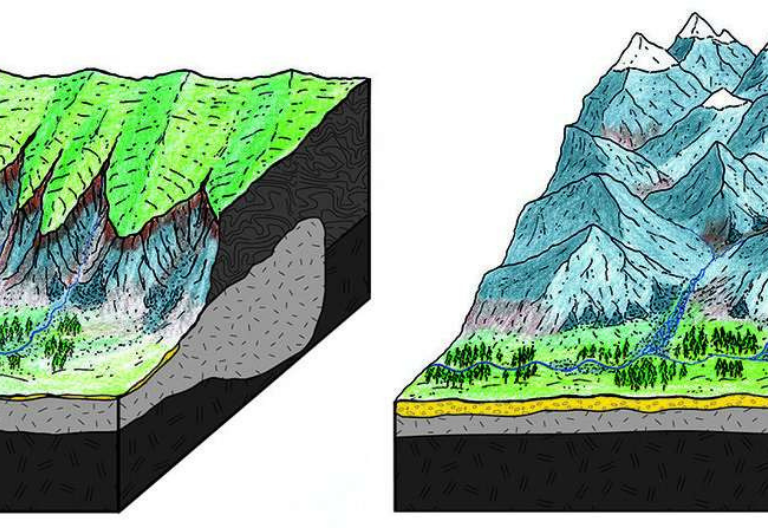
» The surface of the Earth is made up of lithospheric plates which are distinguished in two types:-
(1) The oceanic and
(2) The continental.
The oceanic plates sink into the Earth’s interior whereas continental plates stay on the surface.
When continental plates collided with each other, they are shortened and compressed while the rock units of their upper parts break or develop folds and move on top of each other, and forming so-called nappes.
» The Alps are made of such nappes which are of two kinds :-
(1) The fold nappes
(2) Thrust sheets
A thrust sheet is a rock unit with a sheet-like geometry that behaves like a solid body and shows only slight internal deformation.
While on the other hand, A fold nappe is characterised by significant internal deformation and strati-graphic inversion at its base and behaves like a viscous body.
Fold nappes show constant shearing direction and a nonlinear increase of shear strain towards their overturned limb with a mylonitic zone at their base. They appear to be formed by heterogeneous simple shear in crustal shear zones.
One fold nappe is the Morcles nappe in the Western Alps. The mechanics by which they are formed and the thermomechanical processes that generated the Alps are still incompletely understood.
The reason is that the geology of the Alps is very complicated and the rocks are highly heterogeneous.
In addition, geological processes take place on vastly different scales from the micro-scale to kilometre scale.
Four Thousanders And Ascents
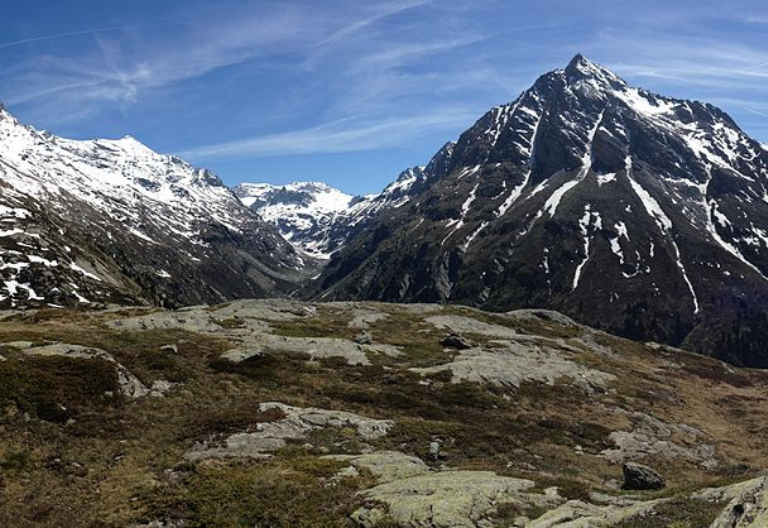
- The Union Internationale des Associations d’Alpinisme (in short known as UIAA) has defined a list of 82 “official” Alpine summits that reaches at least 4,000 m (13,123 ft).
- The list includes not only mountains, but also sub peaks with little prominence that are considered important mountaineering objectives.
- While Mont Blanc was first climbed in the year 1786, and most of the Alpine four-thousanders were climbed during the second half of the 19th century.
- The ascent of the Matterhorn in 1865 marked the end of the golden age of alpinism.
- Karl Blodig (1859–1956) was the first to successfully climb all the major 4,000 m peaks. He completed his series of ascents in the year 1911.
- The first British Mont Blanc ascent was in 1788.
- The first female ascent was in 1819.
- By the mid-1850s Swiss mountaineers had ascended most of the peaks and were eagerly sought as mountain guides.
- Edward Whymper reached the top of the Matterhorn in 1865 (after seven attempts), and in 1938 the last of the six great north faces of the Alps was climbed with the first ascent of the Eiger Nordwand (north face of the Eiger).
Some of the Alpine four thousanders are as follows :-
| NAME | HEIGHT ( IN METERS) | RANGE | COUNTRY |
| MONT BLANC | 4810 | GRAIAN ALPS | ITA, FRA |
| MONT ROSA | 4634 | PENNINE ALPS | ITA, CHE |
| DOM | 4545 | PENNINE ALPS | CHE |
| WEISSHORN | 4506 | PENNINE ALPS | CHE |
| MATTERHORN | 4478 | PENNINE ALPS | ITA, CHE |
| DENT BLANCHE | 4357 | PENNINE ALPS | CHE |
| GRAND COMBIN | 4314 | PENNINE ALPS | CHE |
| FINSTERAARHORN | 4273 | BERNESE ALPS | CHE |
| GRANDES JORASSES | 4208 | GRAIAN ALPS | ITA, FRA |
| RIMPFISCHHORN | 4199 | PENNINE ALPS | CHE |
| ALETSCHHORN | 4193 | BERNESE ALPS | CHE |
| DENT D’ HERENS | 4171 | GRAIAN ALPS | ITA, CHE |
| JUNGFRAU | 4158 | BERNESE ALPS | CHE |
| AIGUILLE VERTE | 4122 | GRAIAN ALPS | FRA |
| MONCH | 4107 | BERNESE ALPS | CHE |
Glaciers
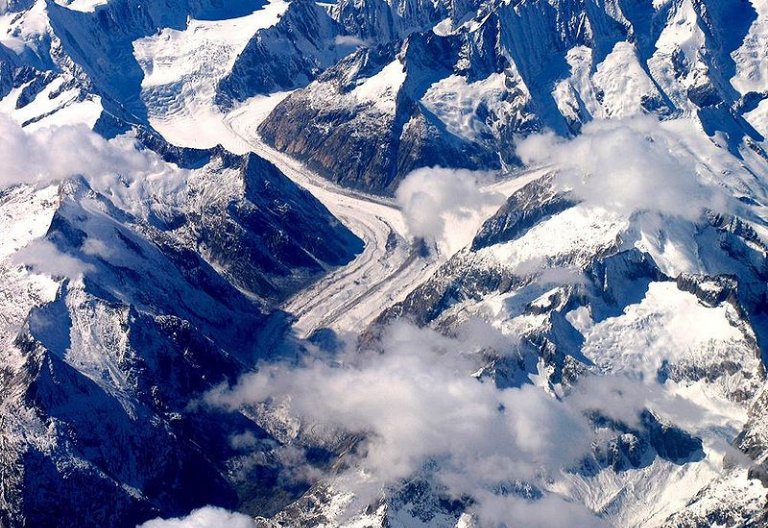
Alpine glaciers are straight rivers of ice, long sweeping rivers, spread in a fan-like shape (Piedmont glaciers), and curtains of ice that hang from vertical slopes of the mountain peaks.
The stress of the movement causes the ice to break and crack loudly, and proves why the mountains were believed to be home to dragons in the medieval period.
The cracking creates unpredictable and dangerous crevasses, often invisible under new snowfall, which cause the greatest danger to mountaineers.
Glaciers end in ice caves, by trailing into a lake or river, or by shedding snowmelt on a meadow.
Sometimes a piece of glacier will detach or break resulting in flooding, property damage and loss of life.
High levels of precipitation cause the glaciers to descend to permafroast levels in some areas whereas in other, more arid regions, glaciers remain above about the 3,500 m (11,483 ft) level.
The 1,817 square kilometres (around 702 sq miles) of the Alps covered by glaciers in 1876 had shrunk to 1,342 km2 (518 sq mi) by 1973, resulting in decreased river run-off levels.
Forty percent of the glaciation in Austria has disappeared since 1850, and 30% of that in Switzerland.
Flora And Fauna
Flora :-
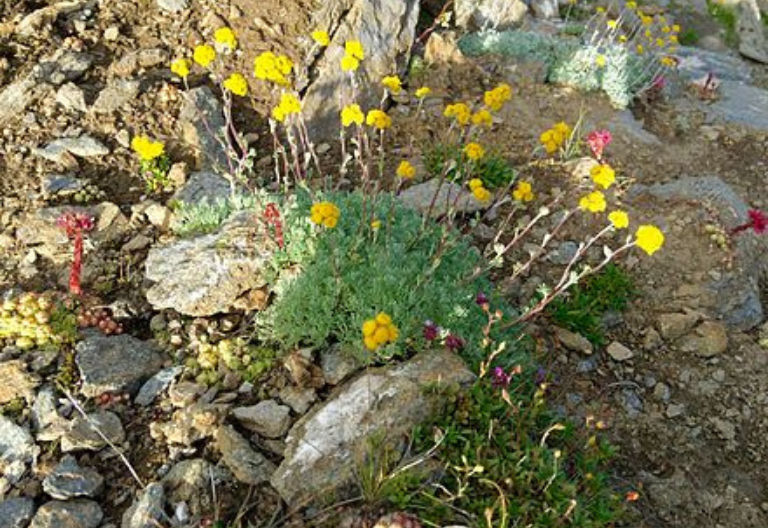
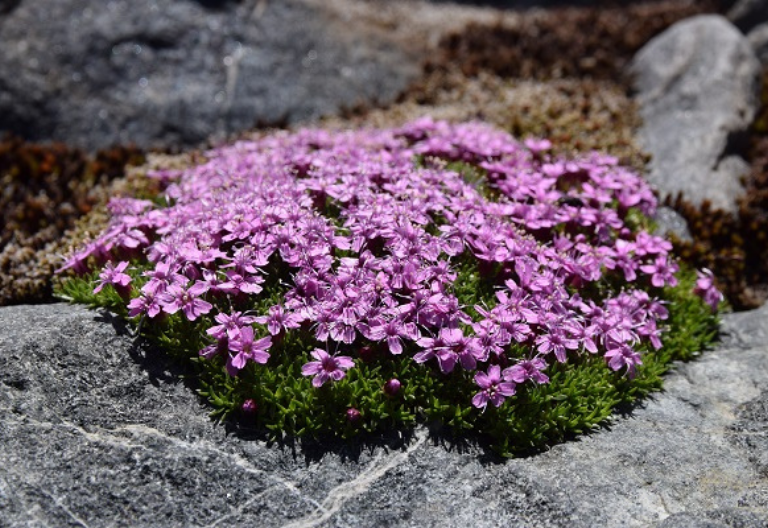

More than thirteen thousand spices of plants have been identified in Alpine region.
Alpine plants are grouped by habitat and soil type which can be limestones or non-calcareous.
The habitats range from meadows, bogs, woodland (deciduous and coniferous) areas to soil-less scree and moraines, and rock faces and ridges.
A natural vegetation limit with altitude is given by the presence of the decidious trees like—oak, beech, ash, etc.
These do not reach exactly to the same elevation, nor are they often found growing together but their upper limit corresponds accurately enough to the change from a temperate to a colder climate that is further proved by a change in the presence of wild herbaceous vegetation.
This limit usually lies about 1,200 m (3,900 ft) above the sea level on the north side of the Alps, but on the southern slopes it often rises to 1,500 m (4,900 ft), sometimes even to 1,700 m (5,600 ft).
Alpine plants such as the Alpine gentian grow in abundance in areas such as the meadows above the Lauterbrunnental. Gentians are named after the Illyrian king Gentius, and 40 species of the early-spring blooming flower grow in the Alps, in a range of 1,500 to 2,400 m (4,900 to 7,900 ft). Writing about the gentians in Switzerland D. H. Lawrence described them as “darkening the day-time, torch-like with the smoking.
Fauna :-
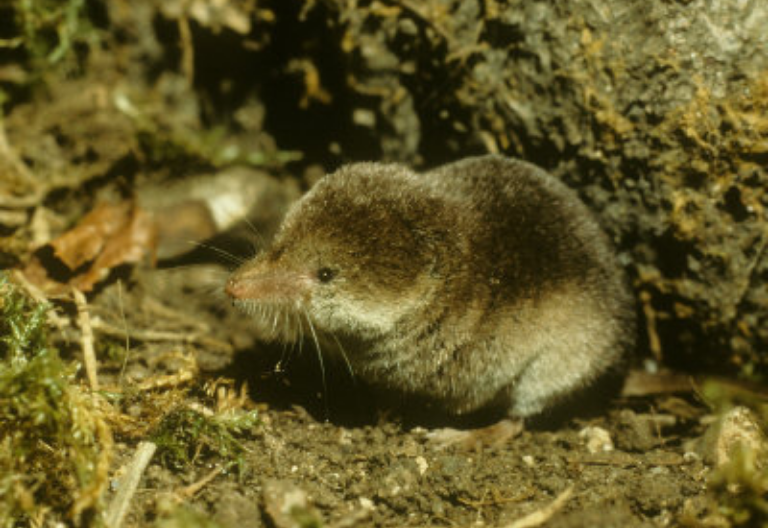

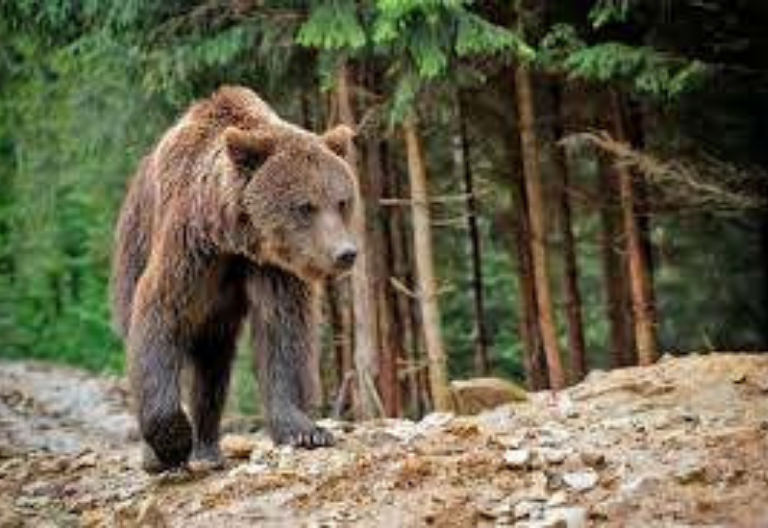

The Alps are a home for more than 30,000 species of wildlife, ranging from the tiniest snow fleas to big brown bears, many of which have made adaptations to the harsh cold conditions and high altitudes to the point that some only survive in specific micro-climates either directly above or below the snow line.
The largest mammal to live in the highest altitudes are the alpine ibex, which have been sighted as high as 3,000 m (which is around 9,800 ft). The ibex live in caves and descend to eat the succulent alpine grasses. Classified as antelopes, chamois are smaller than ibex and found throughout the Alps, living above the tree line and are common in the entire alpine range.
Areas of the eastern Alps are still home to big brown bears. In Switzerland the canton of Bern was named for the bears but the last bear is recorded as having been killed in the year 1792 above Kleine Scheidegg by three hunters from Grindelwald.
Many rodents such as voles live underground. Marmots live almost exclusively above the tree line as high as 2,700 m (8,900 ft). They hibernate in large groups to provide warmth, and can be found in all areas of the Alps, in large colonies they build beneath the alpine pastures. Golden eagles and bearded vultures are the largest birds to be found in the Alps; they nest high on rocky ledges and can be found at altitudes of 2,400 m (7,900 ft). The most common bird is the alpine chough which can be found scavenging at climber’s huts or at the Jungfraujoch, a high altitude tourist destination.
Reptiles such as adders and vipers live up to the snow line the reason is because they cannot bear the cold temperatures they hibernate underground and soak up the warmth on rocky ledges. The high-altitude Alpine salamanders have adapted to live above the snow line by giving birth to fully developed young rather than laying eggs. Brown trout can be found in the streams up to the snow line. Molluscs such as the wood snail live up the snow line. Popularly gathered as food, the snails are now protected.
A number of species of moths live in the Alps, some of which are believed to have evolved in the same habitat up to 120 million years ago, long before the Alps were created.
Twelve species of beetles have habitats up to the snow line; the most beautiful and formerly collected for its colours but now protected is Rosalia alpina Spiders, such as the large wolf spider, live above the snow line and can be seen as high as 400 m (1,300 ft). Scorpions can be found in the Italian Alps.
Some of the species of moths and insects show evidence of having been indigenous to the area from as long ago as the Alpine orogeny. In Emosson in Valais, Switzerland, dinosaur tracks were found in the 1970s, dating probably from the Triassic Period.
Alpine People And Culture
The population of the region is around 14 million spread across eight countries. On the rim of the mountains, the plateaus and the plains the economy consists of manufacturing and service jobs whereas in the higher altitudes and in the mountains farming is still essential to the economy. Even we can say at higher altitude farming is the primary option. Farming and forestry continue to be mainstays of Alpine culture, industries that provide for export to the cities and maintain the mountain ecology.
Much of the Alpine culture is unchanged since the medieval period when skills that guaranteed survival in the mountain valleys and in the highest villages became mainstays, and leading to strong traditions of different skills such as carpentry, woodcarving, baking and pastry-making, and cheesemaking.
Farming had been a traditional occupation for centuries, although it became less dominant in the 20th century with the rise of tourism. Grazing and pasture land are limited because of the steep and rocky topography of the Alps region.
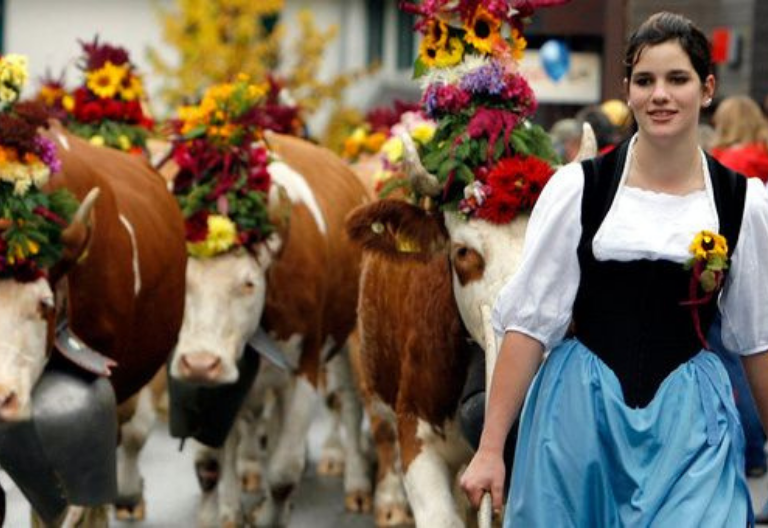
- In mid-June cows are moved to the highest pastures close to the snowline, where they are watched by herdsmen who stay in the high altitudes and they lives in stone huts or wooden barns during the summers. Villagers celebrate the day the cows are herded up to the pastures and again when they return in mid-September. The Almabtrieb, Alpabzug, Alpabfahrt, Désalpes (“coming down from the alps”) is a kind of festival and is celebrated by decorating the cows with garlands and enormous cowbells while the farmers dresses in traditional costumes.

- Cheesemaking is an ancient tradition in most Alpine countries. A wheel of cheese from the Emmental in Switzerland can weigh up to 45 kg (around 100 lb), and the Beaufort in Savoy can weigh up to 70 kg (around 150 lb). Owners of the cows traditionally receive from the cheesemakers a portion in relation to the proportion of the cows’ milk from the summer months in the high alps.
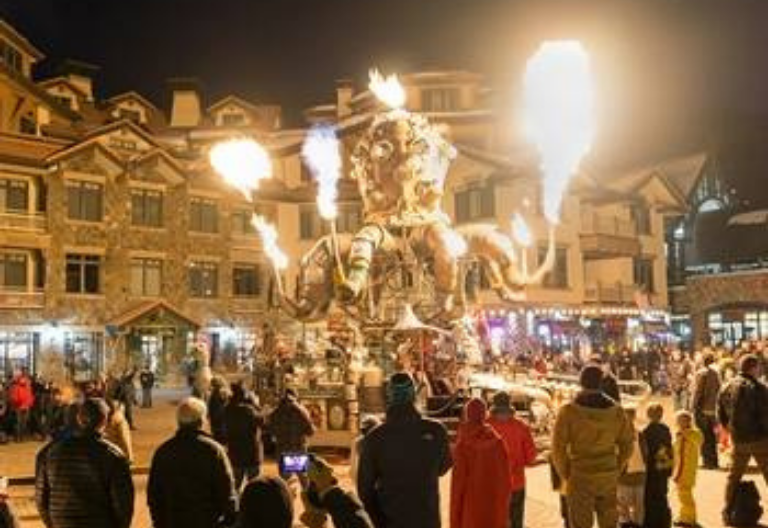
- Haymaking is an important farming activity in mountain villages which has become somewhat mechanized in recent years, although the slopes are so steep that usually scythes are important to cut the grass. Hay is normally brought twice a year, often in festival days.
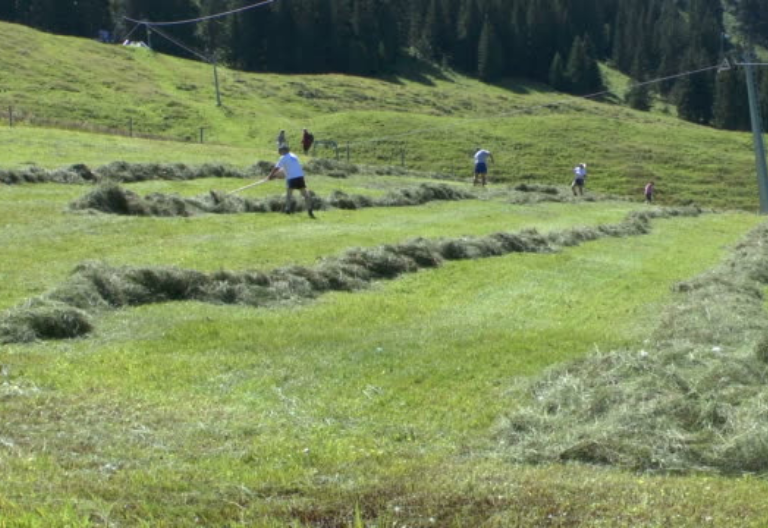
- Alpine festivals vary from country to country and often include the display of local costumes such as dirndl and trachten, the playing of Alpenhorns, wrestling matches, some pagan traditions such as Walpurgis Night and, in many areas, Carnival is celebrated before Lent.
In the high villages people live in homes built in medieval designs that withstand cold winters. The kitchen is separated from the living area (called the stube, the area of the home heated by a stove), and second-floor bedrooms benefit from rising heat. The typical Swiss chalet originated in the Bernese Oberland. Chalets often face south or downhill, and are built of solid wood, with a steeply gabled roof to allow accumulated snow to slide off easily. Stairs leading to upper levels are sometimes built on the outside, and balconies are sometimes enclosed.
Food is passed from the kitchen to the stube, where the dining room table is placed. Some meals are communal, such as fondue where a pot is set in the middle of the table for each person to dip into. Other meals are still served in a traditional manner on carved wooden plates. Furniture has been traditionally elaborately carved and in many Alpine countries carpentry skills are passed from generation to generation.
Roofs are traditionally constructed from Alpine rocks such as pieces of schist, gneiss or slate. Such chalets are typically found in the higher parts of the valleys, as in the Maurienne valley in Savoy, where the amount of snow during the cold months is important. The inclination of the roof cannot exceed 40%, allowing the snow to stay on top, thereby functioning as insulation from the cold. In the lower areas where the forests are widespread, wooden tiles are traditionally used. Commonly made of Norway spruce, they are called “tavaillon”.
The Alpine regions are multicultural and linguistically diverse. Dialects are common, and vary from valley to valley and region to region. In the Slavic Alps alone 19 dialects have been identified.
Some of the French dialects spoken in the French, Swiss and Italian alps of Aosta Valley derive from Arpitan, while the southern part of the western range is related to Old Provençal. the German dialects derive from Germanic tribal languages. Romansh, spoken by two percent of the population in southeast Switzerland, is an ancient Rhaeto-Romanic language derived from Latin, remnants of ancient Celtic languages and perhaps Etruscan.
Avlanche

In 17th century French-Italian border avalanche:- In the 17th century about 2500 people were killed by an avalanche in a village on the French-Italian border.
19th century Zermatt avalanche:- In the 19th century 120 homes in a village near Zermatt were destroyed by an avalanche.
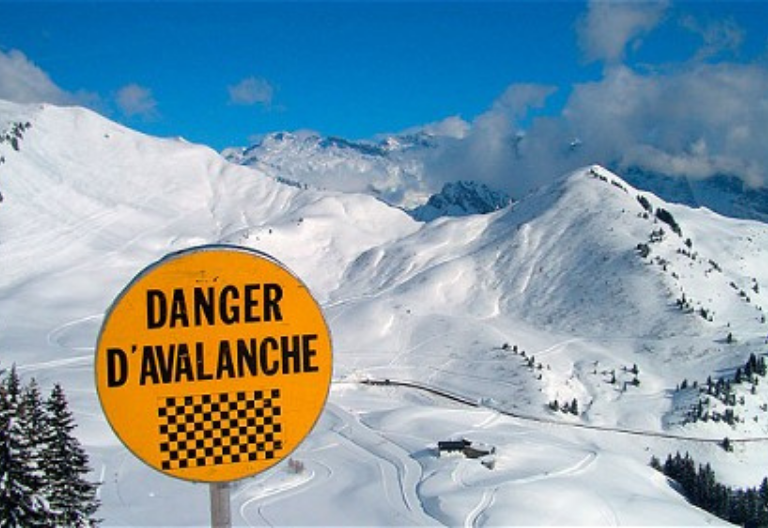
- December 13, 1916 Marmolada-mountain-avalanche
- 1950–1951 winter-of-terror avalanches
- February 9, 1999 Montroc avalanche
- February 21, 1999 Evolene avalanche
- February 23, 1999 Galtur avalanche the deadliest avalanche in the Alps in 40 years.
- July 2014 Mont-Blanc avalanche
- January 13, 2016 Les-Deux-Alpes avalanche
- January 18, 2016 Valfrejus avalanche
Top 13 Intresting Facts About Alps
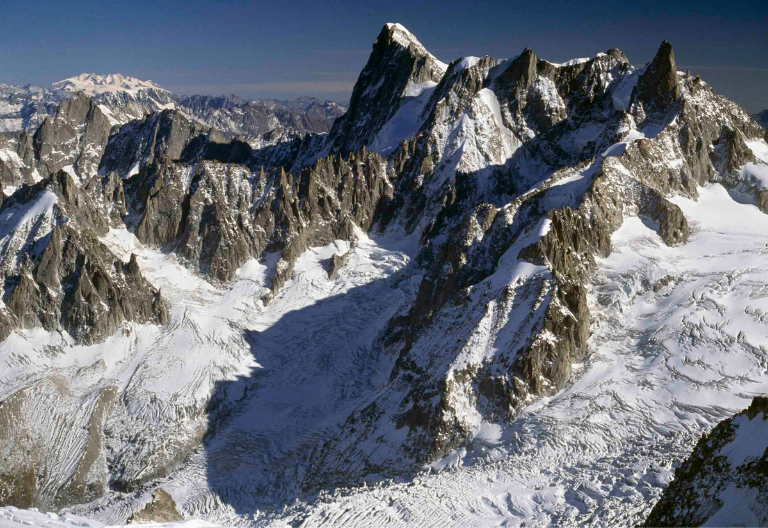
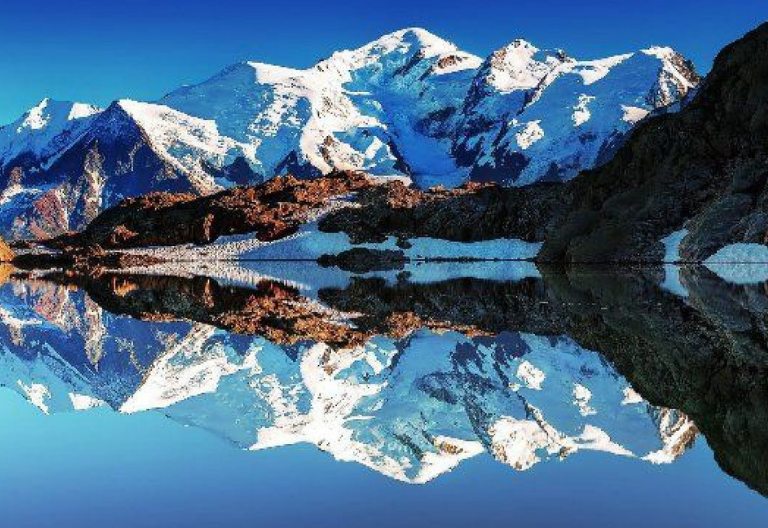

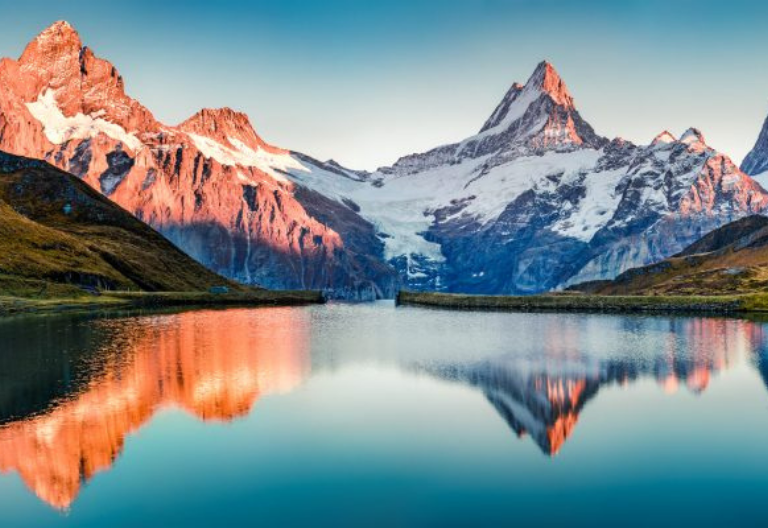
(1) Humans have been living in the Alps for 60,000 years.
(2) The Alps are the youngest mountains in Europe and began to form about 65 million years ago when the African crustal plate shifted into Europe.
(3) Mont Blanc stands at 4800 meters above the sea level, which makes it the highest of all the peaks in Alps.
(4) The Alps had an area of 1,817 sq. km covered by glaciers. That was in 1876. By 1973, the area covered by glaciers had reduced to 1,342 square km.
(5) Otzi the Iceman, a mummified man believed to be 5,000-years-old, was discovered in the Alps in 1991.
(6) The Alpine region has 14 million inhabitants.
(7) People call Grenoble the capital city of the Alps. Boasting 500,000 residents, it is the biggest city in the Alps.
(8) You can find crystals like quartz and cinnabar throughout the Alps.
(9) The Alpine region area contains about a hundred peaks higher than 4,000 m (13,123 ft), known as the “four-thousanders”.
(10) The Alpine crests isolate one European region from another and are the source of many of Europe’s major rivers.
(11) Napoleon was in the Alps in 1800. He crossed one of the mountain passes, a task made more difficult by the fact that he had an army of 40,000.
(12) In World War II, Adolf Hitler kept a base of operation in the Bavarian Alps throughout the war.
(13) The Alps have been turned out one of the most visited mountain ranges in the world. According to the sources, around 120 million tourists visit the Alps every year.



